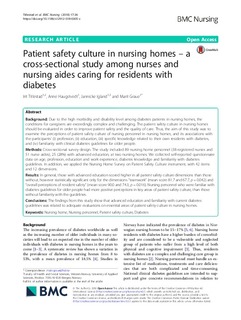| dc.contributor.author | Titlestad, Irit | |
| dc.contributor.author | Haugstvedt, Anne | |
| dc.contributor.author | Igland, Jannicke | |
| dc.contributor.author | Graue, Marit | |
| dc.coverage.spatial | Norway | nb_NO |
| dc.date.accessioned | 2019-02-01T13:44:48Z | |
| dc.date.available | 2019-02-01T13:44:48Z | |
| dc.date.created | 2019-01-25T00:09:18Z | |
| dc.date.issued | 2018 | |
| dc.identifier.citation | Titlestad, I., Haugstvedt, A., Igland, J., & Graue, M. (2018). Patient safety culture in nursing homes: A cross-sectional study among nurses and nursing aides caring for residents with diabetes. BMC Nursing, 17(1), 1-8. | nb_NO |
| dc.identifier.issn | 1472-6955 | |
| dc.identifier.uri | http://hdl.handle.net/11250/2583530 | |
| dc.description.abstract | Background
Due to the high morbidity and disability level among diabetes patients in nursing homes, the conditions for caregivers are exceedingly complex and challenging. The patient safety culture in nursing homes should be evaluated in order to improve patient safety and the quality of care. Thus, the aim of this study was to examine the perceptions of patient safety culture of nursing personnel in nursing homes, and its associations with the participants’ (i) profession, (ii) education, (iii) specific knowledge related to their own residents with diabetes, and (iv) familiarity with clinical diabetes guidelines for older people.
Methods
Cross-sectional survey design. The study included 89 nursing home personnel (38 registered nurses and 51 nurse aides), 25 (28%) with advanced education, at two nursing homes. We collected self-reported questionnaire data on age, profession, education and work experience, diabetes knowledge and familiarity with diabetes guidelines. In addition, we applied the Nursing Home Survey on Patient Safety Culture instrument, with 42 items and 12 dimensions.
Results
In general, those with advanced education scored higher in all patient safety culture dimensions than those without, however statistically significant only for the dimensions “teamwork” (mean score 81.7 and 67.7, p = 0.042) and “overall perceptions of resident safety” (mean score 90.0 and 74.3, p = 0.016). Nursing personnel who were familiar with diabetes guidelines for older people had more positive perceptions in key areas of patient safety culture, than those without familiarity with the guidelines.
Conclusions
The findings from this study show that advanced education and familiarity with current diabetes guidelines was related to adequate evaluations on essential areas of patient safety culture in nursing homes. | nb_NO |
| dc.language.iso | eng | nb_NO |
| dc.publisher | BioMed Central | nb_NO |
| dc.rights | Navngivelse 4.0 Internasjonal | * |
| dc.rights.uri | http://creativecommons.org/licenses/by/4.0/deed.no | * |
| dc.subject | nursing home | nb_NO |
| dc.subject | nursing personnel | nb_NO |
| dc.subject | patient safety culture | nb_NO |
| dc.subject | diabetes | nb_NO |
| dc.title | Patient safety culture in nursing homes – a cross-sectional study among nurses and nursing aides caring for residents with diabetes | nb_NO |
| dc.type | Journal article | nb_NO |
| dc.type | Peer reviewed | nb_NO |
| dc.description.version | publishedVersion | nb_NO |
| dc.rights.holder | © The Author(s). | nb_NO |
| dc.subject.nsi | VDP::Medisinske Fag: 700::Helsefag: 800::Sykepleievitenskap: 808 | nb_NO |
| dc.source.pagenumber | 8 | nb_NO |
| dc.source.volume | 17 | nb_NO |
| dc.source.journal | BMC Nursing | nb_NO |
| dc.source.issue | 1 | nb_NO |
| dc.identifier.doi | 10.1186/s12912-018-0305-z | |
| dc.identifier.cristin | 1664835 | |
| cristin.unitcode | 203,11,1,0 | |
| cristin.unitcode | 203,11,0,0 | |
| cristin.unitname | Institutt for helse- og omsorgsvitskap | |
| cristin.unitname | Fakultet for helse- og sosialvitskap | |
| cristin.ispublished | true | |
| cristin.fulltext | original | |
| cristin.qualitycode | 1 | |

